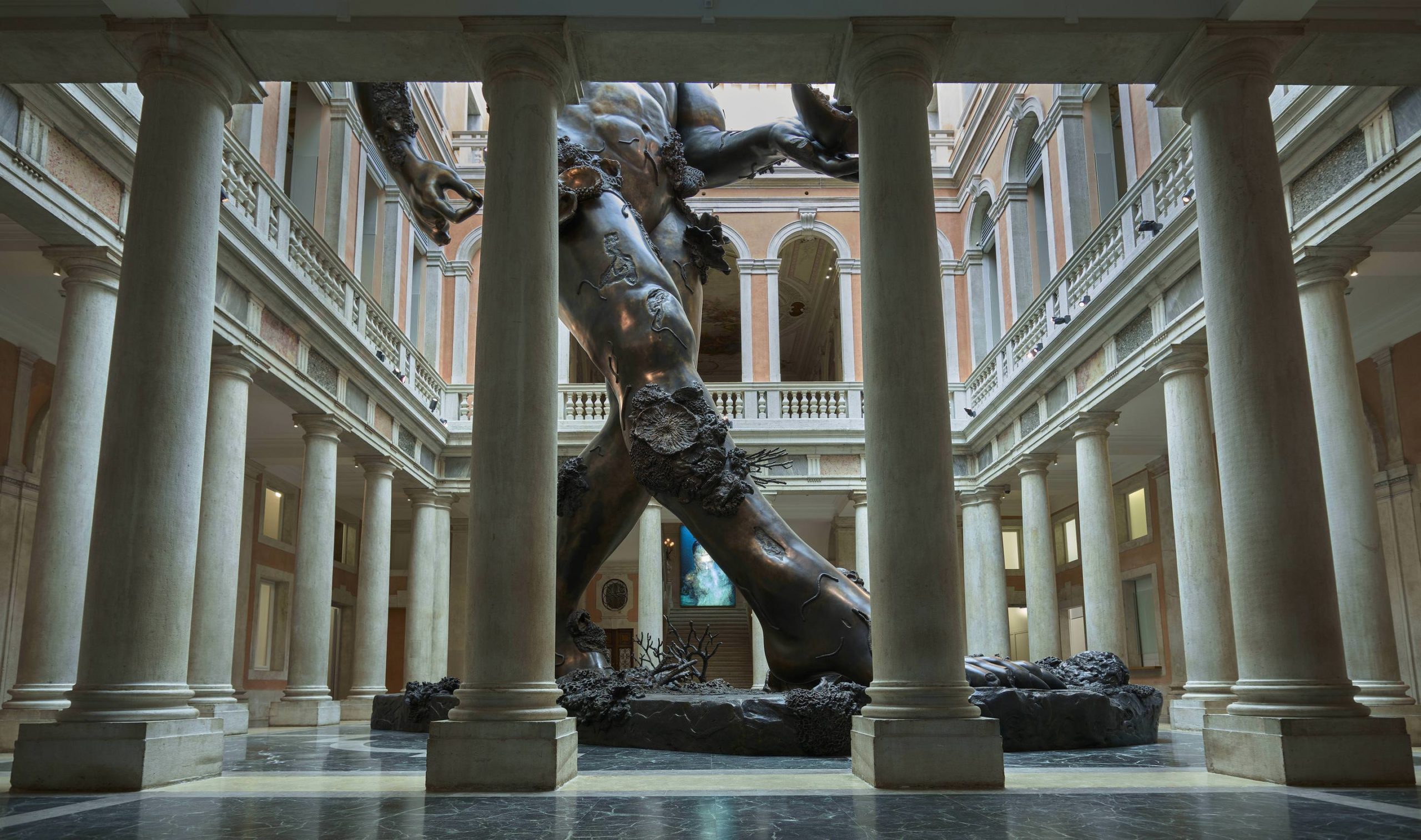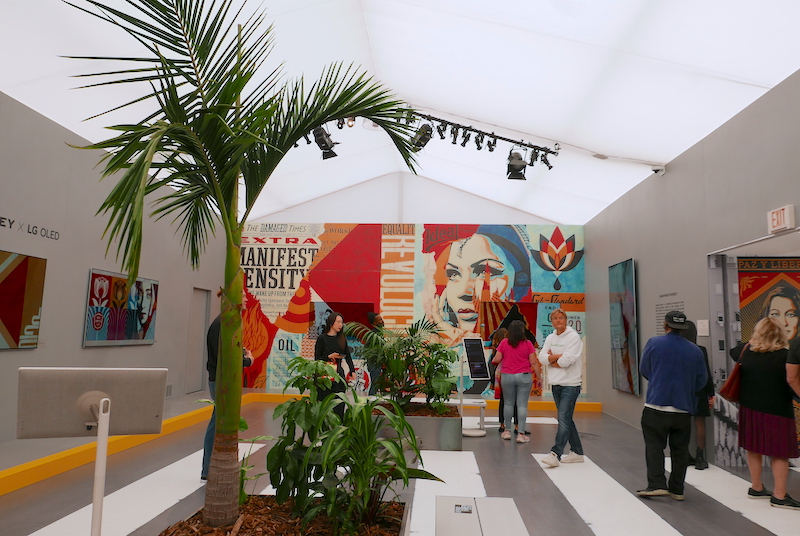This year’s Frieze Art Fair in London was filled to the gunnels with a rowdy and diverse collection of artworks. Here, in no particular order, we’ve selected our favorite seven works at the fair.
Jeff Koons, Sacred Heart (1994-2007)
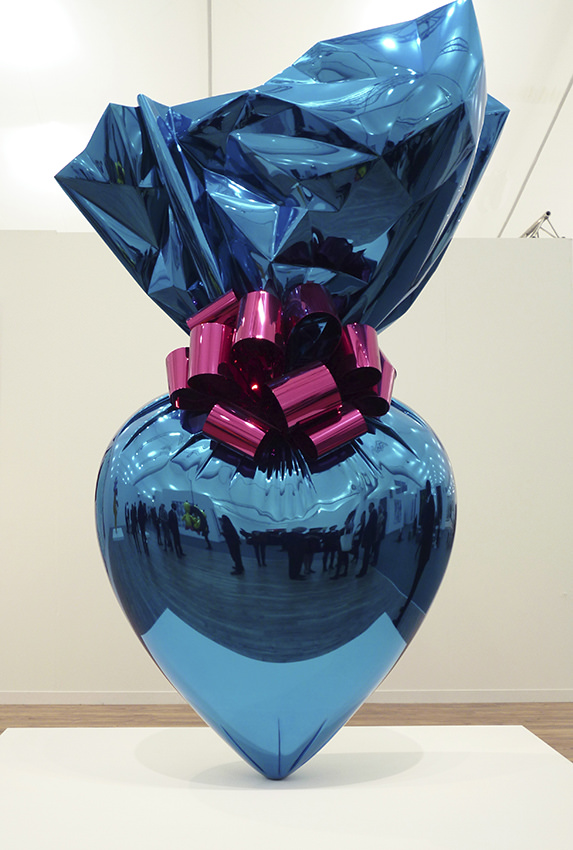
Photo by Whitewall
Jeff Koons is the perfect art fair artist, whose work wows you as you walk past, but doesn’t require getting up close and personal – which is impossible, anyway, thanks to the hoards of visitors at Frieze. This year, Gagosian dedicated their entire booth to the artist, whose enormous, garish sculptures could be seen all the way from the far end of the tent. Yet, for some reason, despite an oversized, Dali-esque lobster and an enormous kitten in a sock, it always remains his Celebration series – colossal high-chromium stainless steel sculptures of balloons and toys and chocolates – which steal the show.
Sacred Heart, a gargantuan chocolate heart wrapped up in that familiar shiny cellophane, references the Willy Wonka dream, as well as religious iconography; its vast, awe-inspiring dimensions, inviting worship. But ultimately, the piece is light hearted and fun.
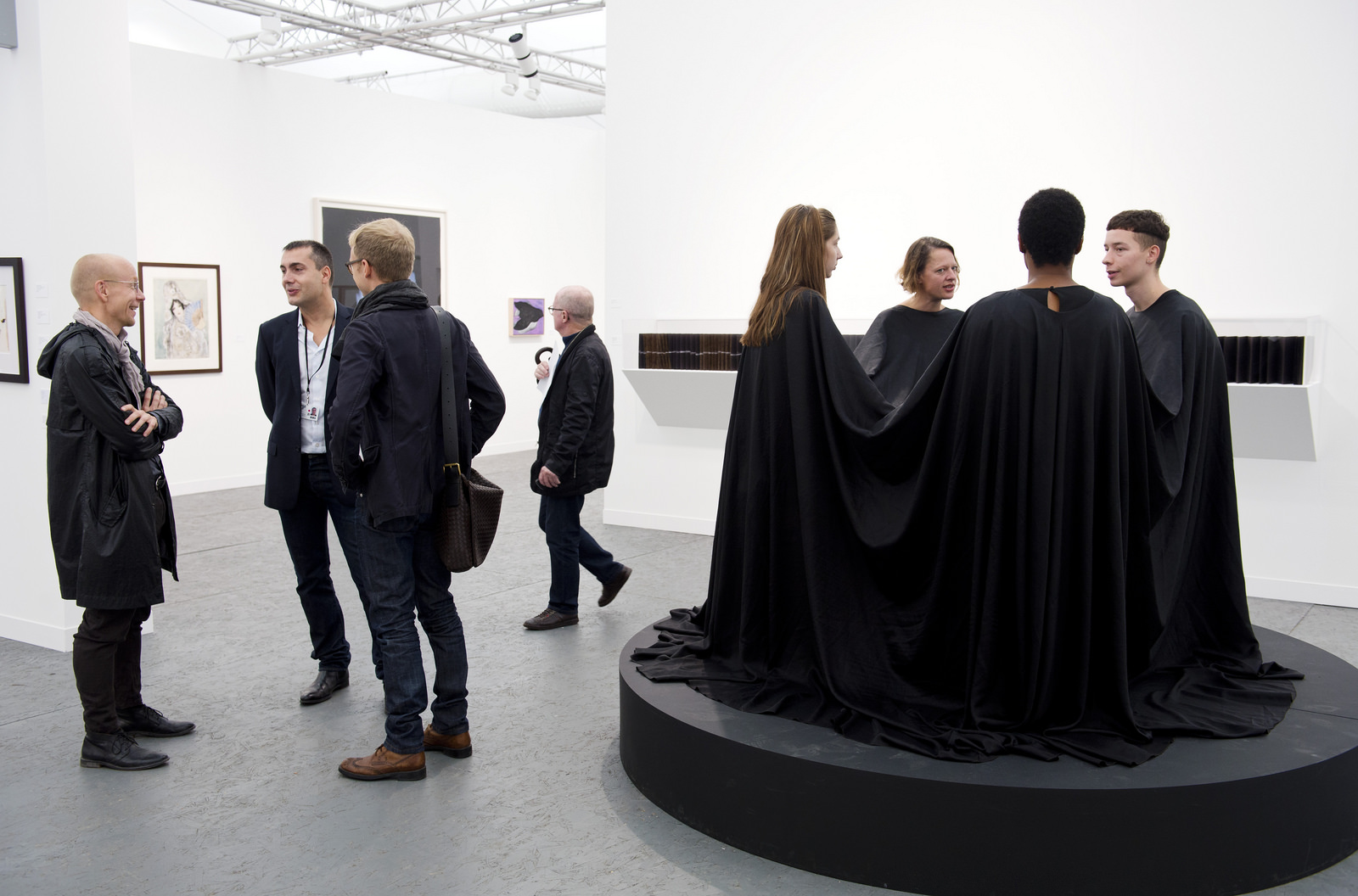
Photograph Linda Nyland
Courtesy of Frieze
Ryan McGinley, You and My Friends (2013)
McGinley’s photographic groupings, You and My Friends, is represented by three galleries at Frieze: Emmanuel Perrotin, Team, and Alison Jacques.
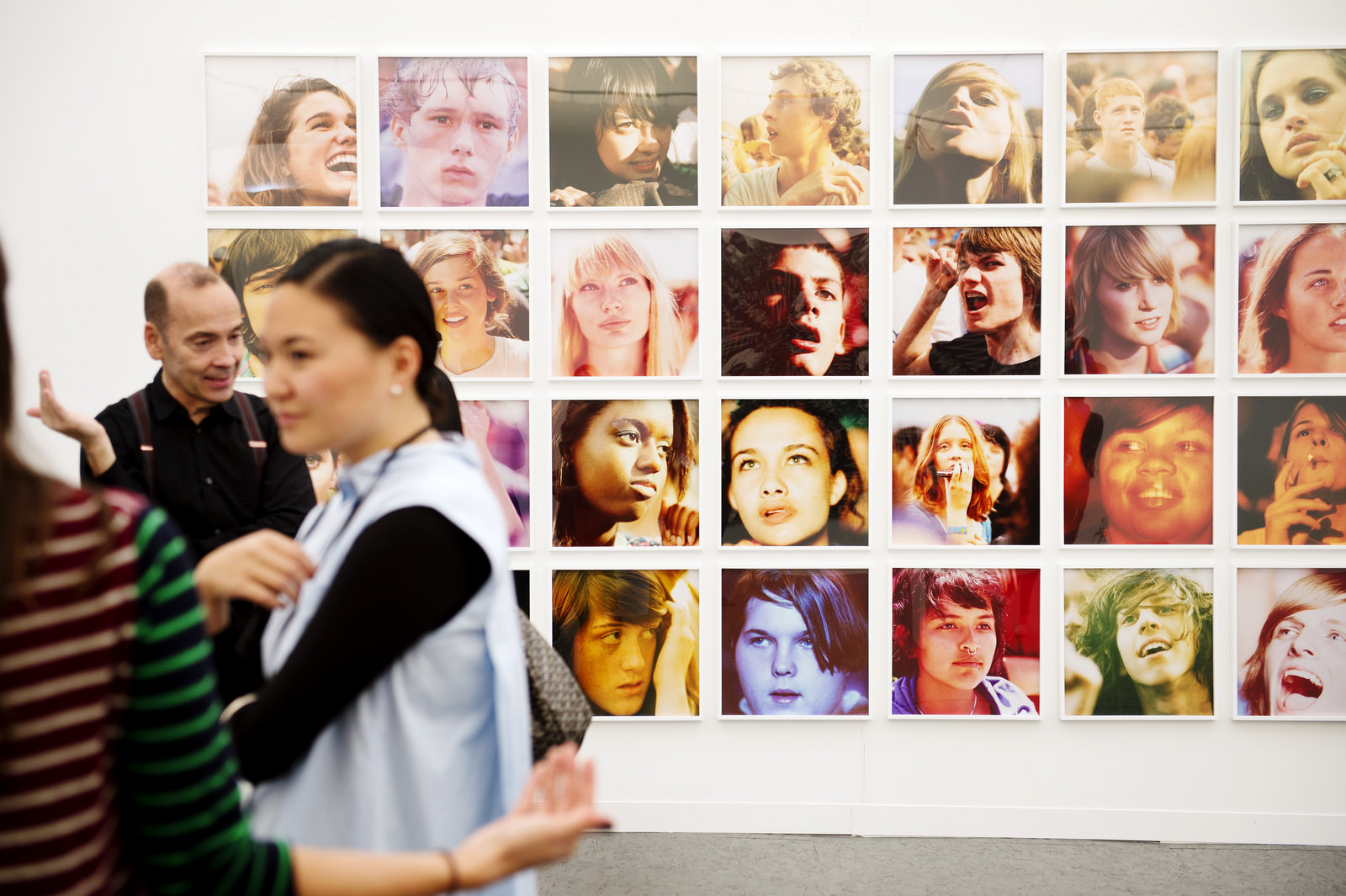
Photograph Linda Nyland
Courtesy of Frieze
The New Jersey-born artist graduated from Parsons School of Design and at 24 went on to become the youngest artist to have a solo show at The Whitney Museum of American Art, The Kids Are Alright (2003). He has since exhibited internationally and won numerous photographic prizes.
Living in New York’s Lower East Side, McGinley’s circle of friends were his main subjects for many years. His highly saturated photographs of youths in nature and at parties present a hedonistic, libertarian beauty, a celebration of the freedom of youth and a virtual rejection of the dark image of adolescence.
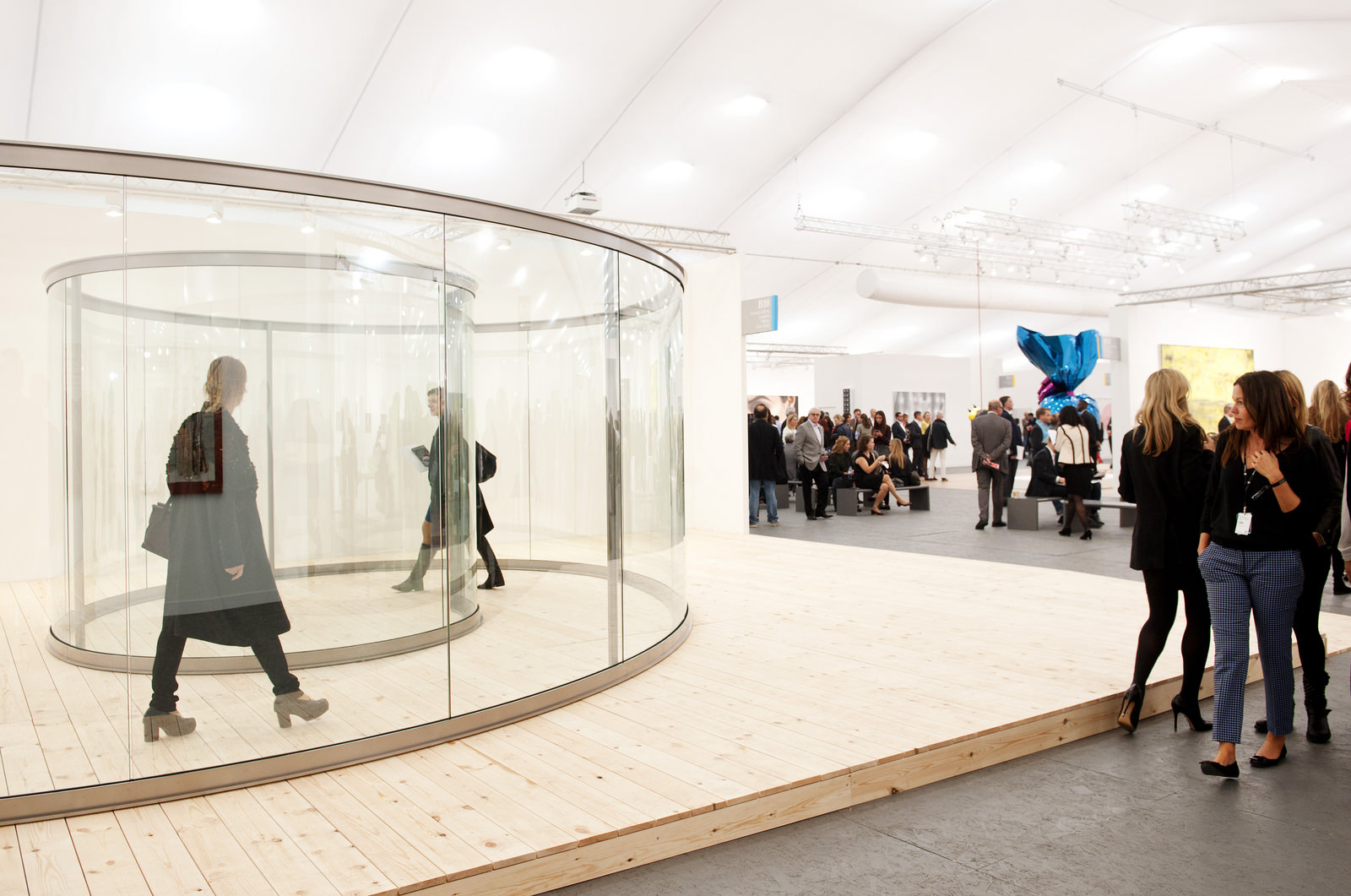
Photograph Linda Nyland
Courtesy of Frieze
The pieces, You and My Friends, belong to a series entitled “Grids,” which comprises groupings of individual photographs presented as one enormous work of art, which could dominate most gallery walls (and certainly an entire booth at Frieze). The photographs show medium format headshots of teenagers watching live bands at music festivals across America and Europe. It recalls his earlier series, “Irregular Regulars,” of individual photographs of fans at Morrissey concerts.
The faces of the subjects – whether pensive, sad or painted with complete ecstasy – all present a vision of pure, unbridled passion completely engrossed by the performances. The emotions are palpable. The result is an intensely beautiful, colorful and poignant piece, which one could stand and stare at for hours.
Jennifer Rubell, Portrait of the Artist (2013)
At the Stephen Friedman Gallery only one work was on view and it easily dominated the entire fair. Rubell’s Portrait of the Artist is an enormous (eight meter long), white fibreglass reclining sculpture of the pregnant artist. In line with most of her oeuvre, the piece is interactive. Her womb is hollowed out, inviting visitors to curl up inside. The piece speaks of the interaction between viewer and artwork, our subconscious desire to return to the womb (which felt entirely heightened in the dreary October chill) and modern society’s need to photograph and document our every move via social media. Visitors could literally become part of the art and Instagram or Tweet it immediately to their followers.
James Lee Byars, Four in a Dress (1967)
If you were expecting bizarre performance art and installations at Frieze, the Michael Werner gallery was the place to get your fix. Two women and two men sit on a circular platform, covered neck to floor by one enormous black cape. This is a 1967 work by the late James Lee Byars. Byars (1932-1997) was a Detroit-born performance and installation artist, who lived an enigmatic and nomadic lifestyle, and whose notable works included The Death of James Lee Byars and The Perfect Smile. Throughout his career, his works often centered on death and the transience of life, which he represented through the use of fragile materials and impermanent creations. He lived in Japan for the best part of a decade to Japanese craft and was known for wearing rather fanciful gold suits. His performances were dramatic and bizarre and he had huge interest in philosophy, travelling to Oxford to question the academics.
Four in a Dress is an intriguing piece. A living sculpture, (the people aren’t for sale, though, only the cape and the concept) the participants chat among themselves, and are even grilled by a few of the visitors. It’s a curious piece, and it certainly attracts attention, startling passing visitors and inviting countless photographs. One can’t help but think, though, that it’s worth is more novel than tangible.
Damien Hirst, Scatter Gun (2013)
At White Cube, the big guns were brought out. Tracey Emin and Antony Gormley sat comfortably amongst other frontrunners but it was a Hirst, which really dominated this booth.
The work is called Scatter Gun. The meandering, swirling colors form a vibrant skull, reminiscent of Día de Muertos or perhaps a Buddhist Mandala. Hirst’s religious fascination is paramount in his work. With closer inspection one can see that the reflective quality of the paint is formed by hundreds of scalpels, arranged in precise patterns. It’s deeply beautiful and a powerful memento mori.
The scalpel paintings form part of a new series, which draws upon his continuing fascination with medical equipment, religious iconography and death. They are an amalgamation of his neatly arranged surgical shelves and his wildly scattered Kaleidescope butterfly triptychs – the power of the combination resulting in skin-crawling magnificence.
Hélio Oiticica & Neville D’Almeida, Maileryn (1973)
Hélio Oiticia & Neville d’Almeida’s Maileryn from the “Cosmococa” series, is on show at Rio de Janeiro gallery booth, A Gentil Carioca.
Helio Oiticia (1937-1980) was a highly influential Brazilian artist, whose abstract modernist paintings and installations named him one of Brazil’s most important artists. He strived to reject the dry academia of the art world and entirely question the meaning behind the practice and experience of art. In 1970, Oiticica moved to New York, where he collaborated with film-maker Neville D’Almeida to create “Cosmococa” (1973–74), a series of nine sensory environments, created by slide projections, soundtracks and other sensory elements, and yet no moving pictures. Oiticica called them his “quasi cinemas.”
Marileryn (1973) takes you into a small, darkened room, whose floor is covered by a layer of sealed sand, and danced upon by free-floating yellow and orange balloons. On the walls and ceiling, photographs of Marilyn Monroe are projected, slowly changing between plain Polaroids and others, embellished with lines of cocaine. Latin music is played through speakers. The room triggers all the senses in an impressively non-aggressive manner despite the loud music, flashing images and obstacles. The overall effect is like an Andy Warhol screen test or a seedy sex club-cum-children’s birthday party. It may be a crowd pleaser, but it’s also a visual treat and an insolent little rebellion.
Dan Graham’s Groovy Spiral (2013)
Dan Graham’s Groovy Spiral is the only work on show at the Lisson Gallery booth. It’s a recently commissioned glass, spiralling pavilion, and the visitors stroll around it contemplatively.
Graham is known for his photography, performance art and large architectural pieces. His work straddles the line between sculpture and architecture, paying homage to his favourite minimalist artists, Donald Judd and Dan Flavin.
In the 1980s he began working on his pavilions – freestanding glass and mirrored objects, which are situated internationally in outdoor spaces. Graham experiments with glass and light, using concave and convex shapes to distort reflections and adding steel and wood to his structures. Some glass is semi-reflective, a type used in skyscrapers, resulting in a clash of the urban and the rural.
Groovy Spiral is a glass and steel helix corridor, which invites visitors to take a walk into its core and back out again. Priced at $600,000 it’s not a cheap experience, but it is an experience. Ironically, the visitors to the pavilion are more on show than anyone else, walking into the artwork to form part of the display. It twists and contorts the notions of viewer and artwork, inside and outside, subject and object of the gaze. It’s a tiny labyrinth, and a real wonder.





